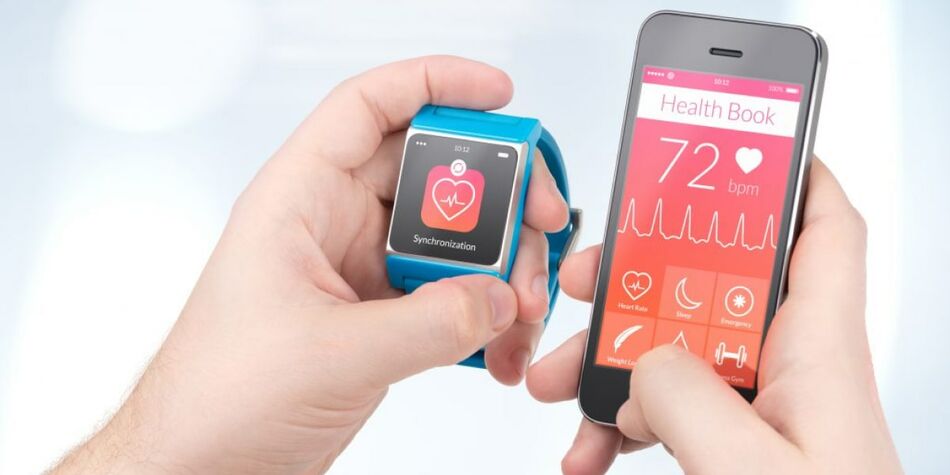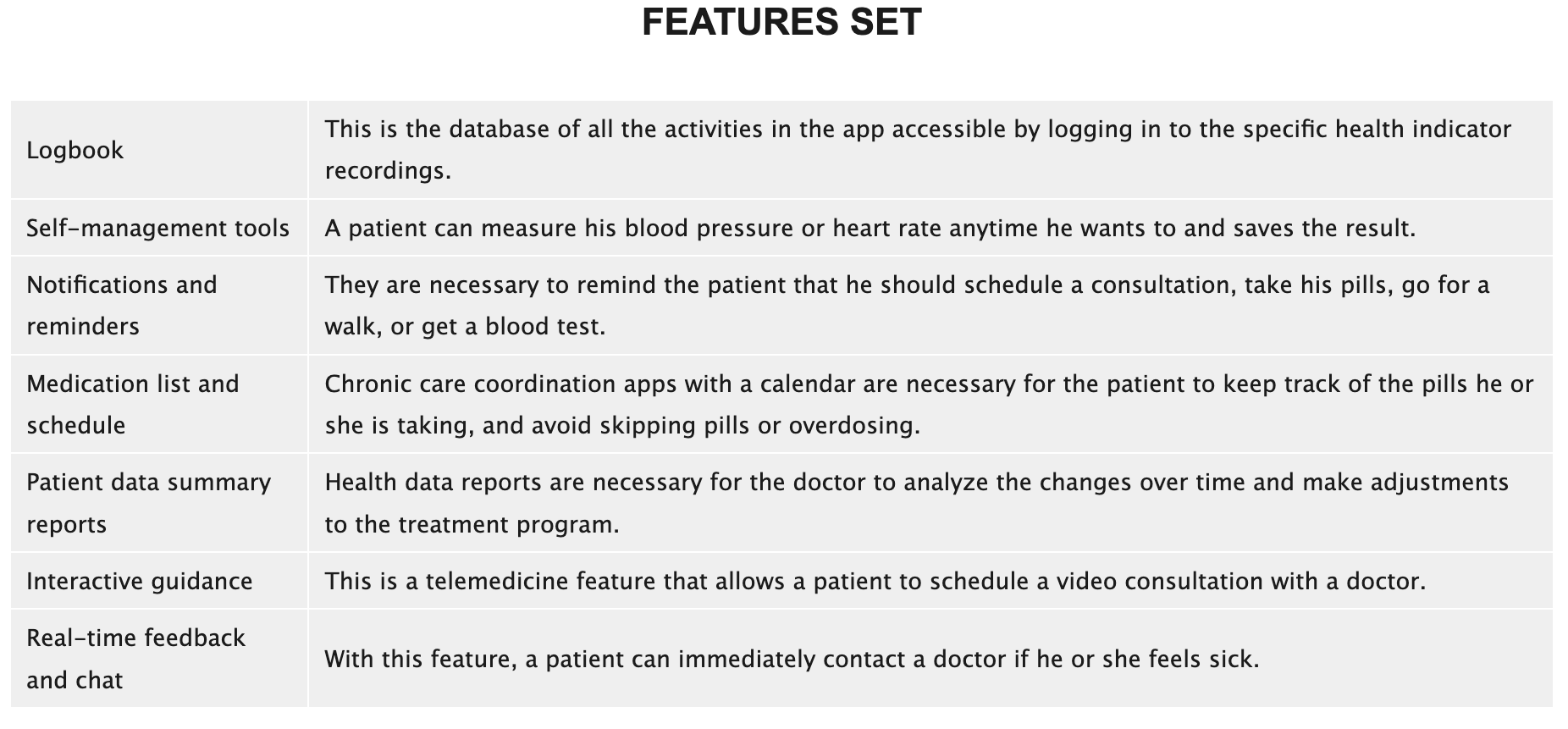A Big Trend in Healthcare: Specialized Apps for Chronic Diseases Management

Today, artificial intelligence (AI), machine learning (ML), augmented reality (AR), the Internet of Things (IoT), and instant data transfer technologies are driving the innovative development of healthcare apps.
Taking into account that 40% of American adults have a chronic disease, chronic disease monitoring is one of the ways for patients to stay informed and lead a healthier lifestyle. We decided to discuss chronic disease management app development with two main purposes: to help people stay healthy and to help hospitals become more efficient.
Overview of Healthcare App Types
The healthcare industry is undergoing a revolution right now. The size of the mobile health app market was estimated at $12.4 billion in 2018 and is expected to reach $236 billion by 2026, according to Grand View Research. This is almost a twenty-fold increase in less than ten years. The market for mobile health applications is already wide and diverse, so it is quite difficult to classify current applications according to single criteria.
We suggest classifying them into five categories based on the target audience and the main problem they solve.
- Everyday health applications are otherwise known as self-managing care apps. This category covers applications that are currently at their peak of popularity among patients. There are all kinds of fitness trackers, calorie counters, sleep and breathing monitors, and yoga and meditation applications.
- Training apps for students and doctors. These are more specific solutions for teaching students and keeping practicing doctors up to date. They can be presented in the form of the broadest knowledge base, as well as powered by augmented reality to hone skills without risking the health of a real patient.
- Electronic medical records (EMR) software. Applications of this type can also be classified as telemedicine solutions, which help a patient receive a remote service without being tied to a specific hospital or doctor on-demand apps.
- Internet of Things (IoT) healthcare apps. The simplest example of such an application is activity counters that are already built into the Apple Watch or any other wearable solution. More specific applications from this category are used by patients who have smart implants such as a heart implant. In this case, the application monitors the operation of the implant and controls the patient’s heart post-surgery.
- Special applications developed for patients with specific needs. These applications solve the problem of monitoring a patient’s blood sugar or blood pressure for example. Chronic disease management software also falls into this category, as these conditions are most often chronic. Next, we will consider the specifics of creating chronic care management apps, and also explain this need.
Reasons to Build an App for Chronic Disease Management
A chronic disease electronic management system is software that is convenient and useful for both patients and doctors. There are three reasons why it would be beneficial for a hospital to have a disease management tool.
- Sell more necessary services. According to the Harvard Business Review, today’s users are more likely to pay for apps that promise some kind of enjoyment like listening to quality music or managing your finances smarter. A disease tracker app cannot promise any visible pleasures. Instead, the app carefully monitors the patient’s vital signs and helps him or her comply with certain restrictions, for example, choosing healthier foods. It also reminds a user of the need to get tested or visit a doctor. Therefore, it is best if such an application is part of medical service and the fee for its use is included in the patient’s bill. This allows the hospital to motivate patients to seek necessary services on time without postponing a visit to a doctor or postponing needed tests.
- Allow patients to control their disease at home. The benefit of a disease tracking app for the patient is clear. He receives all the necessary information about his health, plus he can stay at home and lead a normal life despite a chronic illness. For the hospital, this means decreased doctor workloads, plus more free beds for patients in urgent need.
- Always have an ultimate picture of a patient’s health status. A dynamic picture of a patient’s condition can provide the doctor with new insights, especially if the application is equipped with artificial intelligence. For example, if the doctor notices that the patient’s condition worsens after certain actions or medications, the physician can change the treatment program in a timely fashion and develop new recommendations.
How to Control Chronic Illnesses with a Mobile App
So, how can apps help manage chronic diseases? People with chronic illnesses need many daily activities in order to keep their health at an optimum level. It’s easy enough to forget to do something, and for patients with memory impairments, the chronic care management app can be a great solution. Here’s what disease management apps can do for patients.
- Take measures. For example, overweight patients can track calories burned and consumed, people with heart disease can track heart rhythms, pulse, and blood pressure, and patients at risk of diabetes can track sugar intake.
- Provide reports. A chronic illness symptom tracker is useful for the doctor as well because with its help he or she can get reports in the form of a chart or a graph, quickly assess the patient’s health condition, and decide whether it is necessary to change the treatment course.
- Suggest necessary actions. Chronic care management software can work either according to a pre-programmed algorithm (for example, it can be programmed to remind a patient to take pills three times a day), or it can be connected to a wearable device and track vital signs 24/7. Being powered by AI, this app can suggest what to do if there are alarming symptoms. The most innovative AI solutions in healthcare can even determine possible deterioration in health (for example, an approaching heart attack) by analyzing imperceptible signals.
Features of Chronic Disease Management
Of course, the feature set for your chronic disease management app will be individualized. The development of this medical solution, like any other, does not exclude the need to research the market, validate the idea and create a set of functions that will simultaneously solve a specific problem and be beneficial for the hospital.
However, it is possible to make a preliminary list of the care system mobile app features that will be enough for a minimum viable product (MVP) to be developed and tested. Below are the main ones.

Conclusion
A chronic disease management system is a way for patients with chronic diseases to support their health and optimize the care delivery process for hospitals. The developed solution should meet the specific needs of both parties. You should contact an experienced vendor to get competent technological support if you are interested in developing a chronic disease management system or app.
Cprime is well-versed in medical app development so get in touch at learn@cprime.com if you are looking for an innovative way to take care of your patients!

